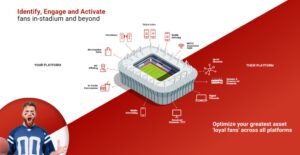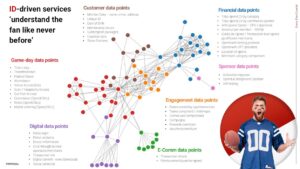AST had the opportunity to exclusively speak to Richard Pinnick from Fortress GB. Richard Pinnick is the SVP of Global Business Development for Fortress GB & US. Fortress is in the business of connecting Sports Brands to their Fan Networks, having built a market leading platform used by over 140 Tier 1 Pro Sports Properties in Europe and North America.
Fortress has used decades of experience to perfect a digital services platform that enables teams to identify, understand, service and transact with their global network of fans. Using the platform, clients operate multi-channel engagement programs including digital ticketing, loyalty, rewards, stored value, merchant connect and social network components. The Fortress services platform uses the latest generation of NFC mobile, RFID contactless and NFC technology. Today, Fortress powers the member strategies of some of the world’s largest sporting & entertainment I.Ps – Boston Red Sox, LA Dodgers, Arsenal FC, Manchester City FC, Liverpool FC, Washington Nationals, Wembley Stadium, FIFA World Cup, UEFA Euros, SuperBowl, and much more.
Pinnick has been a part of the business since its early stages of funding and has driven the expansion of Fortress. In this Q&A, Pinnick sheds valuable light on the evolution of fan engagement in recent years and how Fortress is helping top sports properties navigate this change.
 AST: How is digital technology changing the behavior of sports fans? What are the trends that you are observing?
AST: How is digital technology changing the behavior of sports fans? What are the trends that you are observing?
Richard: “Digital technology is opening new options for Sports Fans to engage directly with their favorite Sports, Teams, and Stars. Across the board, but particularly with Gen Z fans, there is a growing movement away from traditional broadcast networks to OTT streaming services. 32% of Gen Z fans watch live sporting events via licensed streaming channels, a significant shift when compared to 24% of all US adults. With the increased cost of attending live sports, more young people are turning to social media channels to access their sporting content. The content they demand is also different – whilst the live experience is still important, it’s only one piece of the puzzle. This means that Teams are having to be increasingly focused on the game beyond the game – how to create content and experiences that gel with today’s world of social media, with its personalities, fashion interests, and general first-person video content. Technological advances now support sports entities that look to offer broadcast, digital and online experiences to all fans, not just one, two, or three ways, but 1,000 ways, if not a million ways. As fandom moves to digital (and blurs the lines between the live, digital, and social) Teams have had to adapt – from upgrading stadium infrastructure to deliver high-speed WIFI, through to the implementations of AR, VR, drone-eye tech, live data, and stats, and ‘back-of-seat’ 2nd screens – all are designed to make the experience more accessible and more akin to the digital storytelling that makes up so much of the Gen Z world.”
AST: How do you see teams/ leagues leveraging those trends to grow and monetize fans that are in other parts of the world from where the teams and leagues play?
Richard: “The shift to digital has opened up the opportunity (some say necessity) for teams/leagues to go direct-to-consumer. For you to leverage, you need to identify, and you need to control the product you are offering. This is something that retailers have been doing for decades – they understand the importance of customer data and providing the right product to the right consumer at the right time.
Sports teams have barely scratched the surface of this methodology – preferring to disintermediate the fan through 3rd party channels – broadcast, social, gaming, and e-commerce – even with ticketing. The next generation will see Teams taking ownership of their own fan identity, and in doing so controlling the gateway to services provided. Others may still provide the service – but through the eco-system owned and managed by the brand.
Whether this is played out at a team level or league level is still undetermined. Sports Teams may ultimately not want to become platform businesses but remain content creators. This opens the opportunity for the League to step in and build the platform.”
AST: How is your platform increasing engagement for sports fans?
Richard: “The Fortress platform offers a suite of tools to enable Teams to better service and engage with their fan base – from access, payments, loyalty, and activation modules. Those service areas enhance operations (be they quicker access to venues or reduced queue time at concessions), but also “add value” to the experience of being a fan by enabling Teams to personalise the service offering to each fan – both in the stadium and beyond.
Fan identity and personalisation are key to optimizing the future relationship between the brand and the fan. Ultimately, it’s about data, and how the industry uses data to make “every fan count” – no matter whether the fan is sitting in the stadium, is in a bar with his friends, or is engaging with content online or the metaverse. Every interaction has value and the sports teams of tomorrow will learn how to best harness this interaction.
So yes, the fan in Asia may not buy a season ticket or attend a game – but they will interact with their beloved team in a myriad of new ways across multiple channels – and the team will sit in the centre of this relationship, know what they are doing, when they do it and in doing so will be able to personalize the services to best add value to the relationship.”




